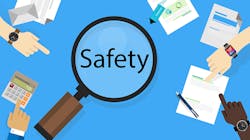SPD administrative controls play key role in staff safety
The Occupational Safety and Health Administration (OSHA) and the National Institute for Occupational Safety and Health (NIOSH) identify five levels of controls for managing workplace hazards: elimination, substitution, engineering controls, administrative controls and personal protective equipment (PPE) (See Figure 1). Elimination tops the NIOSH hierarchy of controls because it physically removes the hazard. In contrast, PPE falls at the bottom of the controls in regard to effectiveness, although it is still essential for employee safety.
This article addresses administrative controls and explains how their use can reduce Sterile Processing-related hazards for employees. While administrative controls are not a permanent solution to eliminating safety risks, they are nonetheless effective and deserving of careful attention because they entail changing work behaviors to limit or prevent hazard exposure and incorporate other controls that reduce employee risk. SP leaders see greater acceptance and implementation of administrative controls when they provide adequate employee training and ensure consistent compliance with policies and procedures aimed at improving staff safety.
With administrative controls, one might assume a hazard must be tolerated because it cannot be eliminated entirely. In the decontamination area, for example, SP professionals routinely encounter wet floors (slip and fall risks), bloodborne pathogens, various chemicals, aerosolization when working at sinks, sharp instruments that can pierce the skin and pose infection risks, and more. Anytime an employee is injured, SP leadership must work to identify the cause and seek solutions to prevent their reoccurrence.
The following are four facets of administrative controls:
Staff training: SP leaders must teach every employee across all shifts why safety procedures must be diligently followed, and they should ensure technicians understand safety concerns and risks and how to identify new problems as they arise, so they can better protect themselves and their co-workers.
Departmental policies: Daily environmental cleaning of SPD areas promotes employee safety and operational efficiency. The SPD (all areas) must be tidied, decluttered and maintained daily by SP employees and thoroughly cleaned by Environmental Services staff. Preventive maintenance measures that help prevent equipment issues and failures is essential versus addressing them reactively, after an issue arises. Instruments and equipment should be routinely and properly serviced. Further, rotating staff members through all areas of the SPD is prudent because it acclimates employees to a range of SP tasks, reducing process/task fatigue and the risk for repetitive motion injuries.
Procedural changes: Safety concerns can be identified and addressed by performing routine procedural reviews and audits. Safe, standardized work practices are critical for creating a high-performing safety culture, and SP leaders should regularly request employee feedback when processes are changed or added. This helps ensure staff buy-in and compliance.
Visual and auditory cues: Manufacturers’ labels for all chemicals, sterilants, lubricants and other SP-related products and supplies should remain intact on their original packaging to ensure proper use and prevent potentially dangerous chemical mix-up or misuse. Warning signs, including those identifying clean or soiled areas, slip hazards or restricted areas, are useful visual cues. Alarms are effective auditory (hearing) cues to identify malfunctions or other potential risks with equipment. An alarm can alert staff to an overheated sterilizer, for example, or when a biological indicator fails in the incubator, and insulation testers in workstations may alarm if an insulation breach occurs.
Conclusion
Administrative controls are critical elements of a comprehensive, carefully developed and well-implemented employee safety program. Adopting these controls and reviewing them regularly to ensure they are appropriate, well understood and followed consistently contributes greatly to an SPD’s safety culture. SP leaders should encourage their teams to identify actual or potential safety risks and share ideas to mitigate them and improve safety for the entire team. Ingraining safety protocols into ongoing employee training and daily staff huddles can reduce safety risks and remind employees that their safety is prioritized.
Marie Brewer, CST, CRCST, CIS, CHL, CER, GTS, CLSSBB, serves as Sterile Processing Manager for St. Luke’s Hospital in Cedar Rapids, Iowa, and is a subject matter expert and columnist for the Healthcare Sterile Processing Association.
About the Author
Marie Brewer
Sterile Processing Manager
Marie Brewer, CST, CRCST, CIS, CHL, CER, GTS, CLSSBB, serves as Sterile Processing Manager for St. Luke’s Hospital in Cedar Rapids, Iowa, and is a subject matter expert and columnist for the Healthcare Sterile Processing Association.
